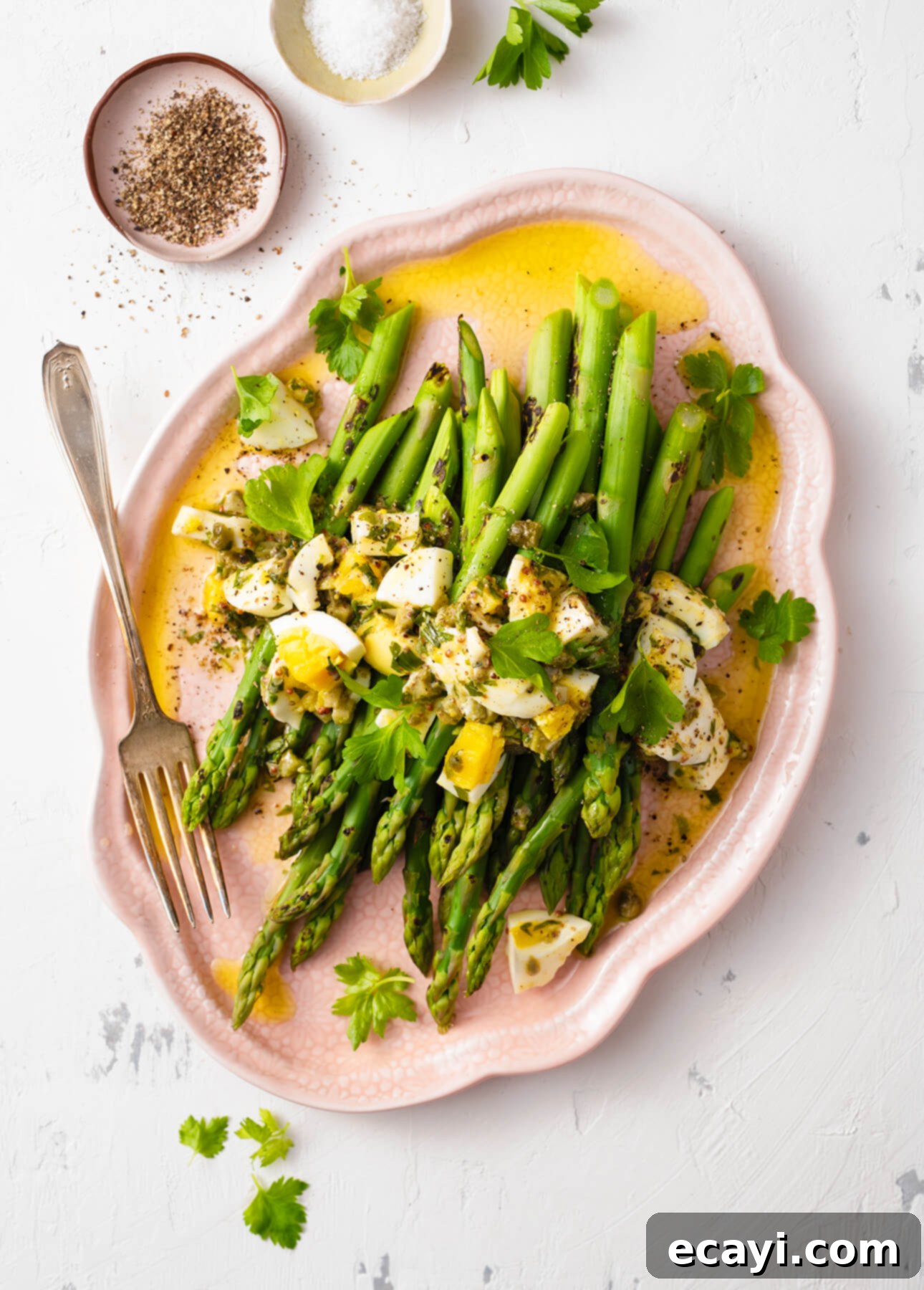Mastering Gribiche Dressing: The Perfect French Condiment for Fresh Spring Asparagus
Welcome the vibrant flavors of spring with a dish that celebrates simplicity and sophistication: crisp-tender asparagus adorned with a luxurious French Gribiche dressing. This classic condiment, made from hard-boiled eggs and a symphony of tangy garnishes like cornichons and capers, transforms fresh spring asparagus into an unforgettable culinary experience.
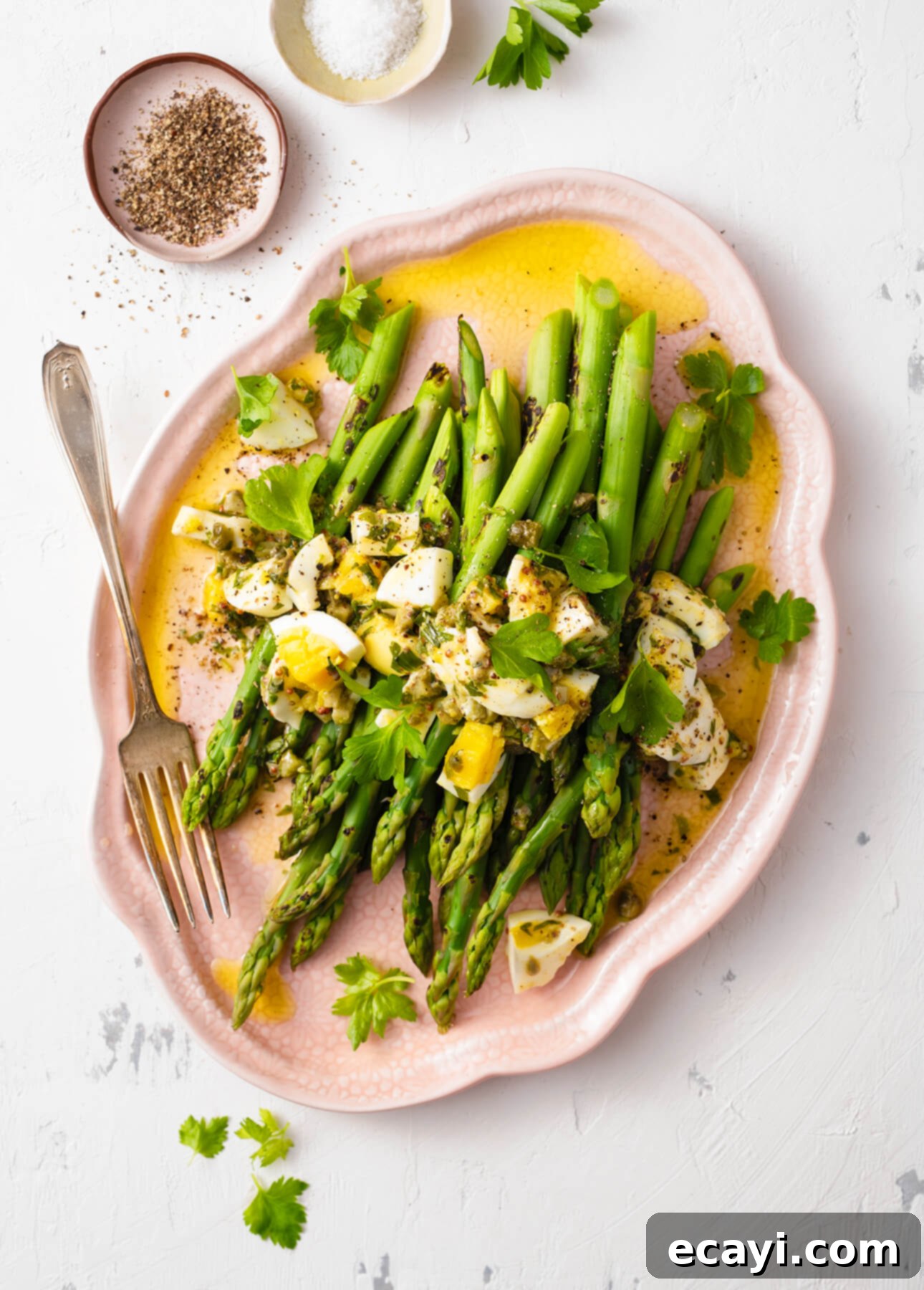
This post contains affiliate links. Full disclosure is at the bottom of the article.
As March ushers in the promise of warmer days, my culinary radar immediately tunes into the farmers’ market, eagerly awaiting the arrival of the first bundles of fresh asparagus. These bright green stalks are more than just a vegetable; they are a vibrant herald of spring, signaling the season of renewal and fresh flavors. Asparagus, with its delicate crunch and earthy sweetness, is incredibly versatile, making it a beloved ingredient in kitchens worldwide. From being shaved thinly and enjoyed raw atop a tartine, to being sautéed and folded into a savory stir-fry, or even featuring prominently in classic brunch staples like Eggs Benedict or Breakfast Pizza, asparagus truly shines in countless preparations. It even makes a fantastic addition to a hearty lunch bowl, adding a touch of verdant goodness.
However, among all the wonderful ways to enjoy this seasonal gem, my absolute favorite involves serving fresh spring asparagus simply steamed and generously topped with a classic French hard-boiled egg dressing known as sauce gribiche. This exquisite condiment shares similarities with mayonnaise but distinguishes itself by incorporating finely chopped hard-boiled eggs instead of fresh yolks, giving it a unique, chunky texture and a richer mouthfeel. The dressing is further elevated with a medley of piquant additions such as finely diced gherkins (cornichons), briny capers, and a fragrant blend of fresh herbs, creating a harmonious balance of flavors and textures that perfectly complements the tender asparagus.
Gribiche dressing is an utterly irresistible French condiment that serves as the ideal companion to crisp-tender asparagus. It transforms a simple vegetable dish into something truly special, making it perfect for an elegant brunch, a sophisticated lunch, or a light yet luxurious dinner. Imagine serving this impressive, yet surprisingly easy, French delicacy alongside smoked salmon and slices of fresh, crusty bread – an ensemble that promises to delight the palate and impress your guests.
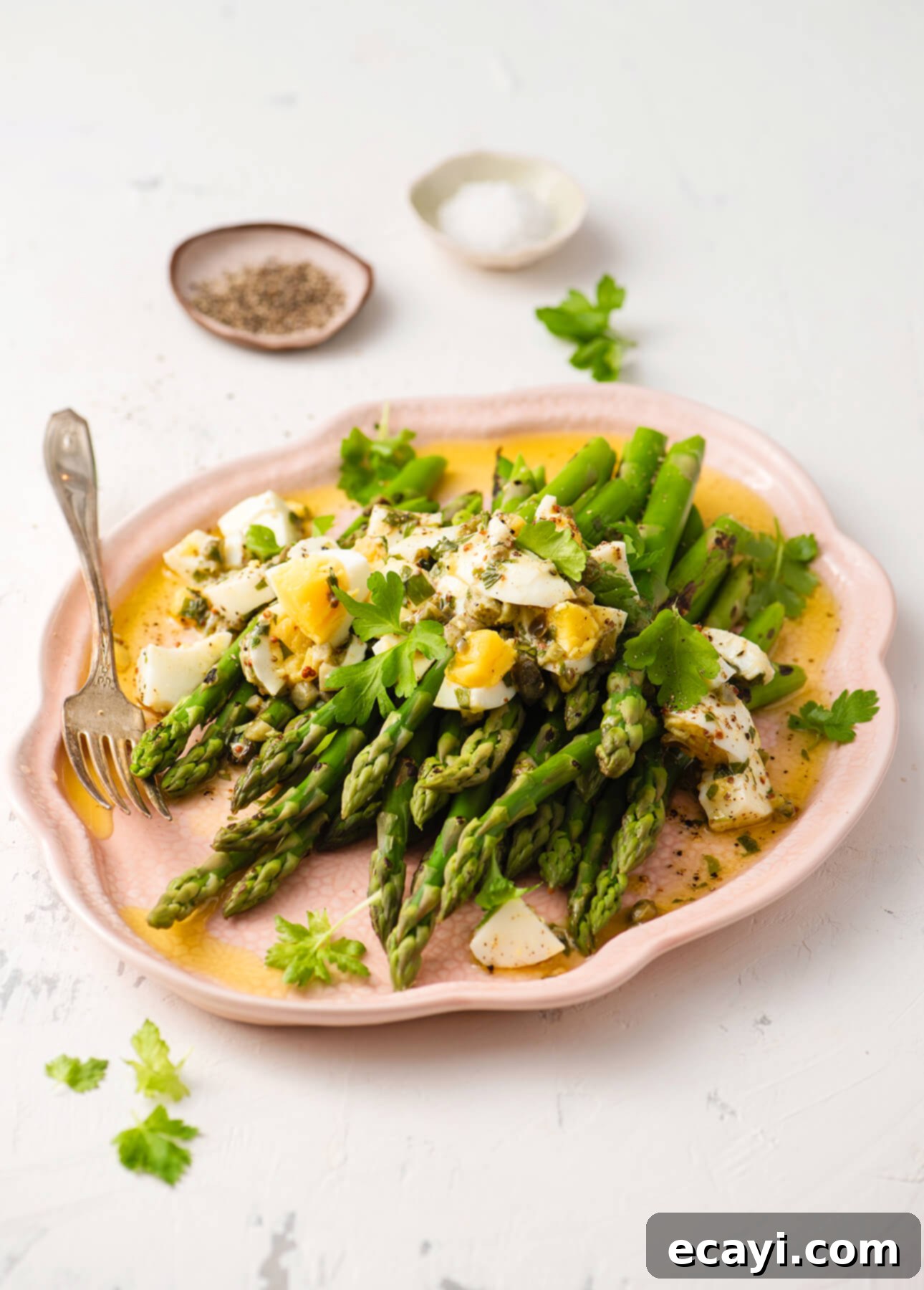
Creative Ways to Serve Gribiche Dressing and Asparagus
While the traditional presentation involves arranging the beautifully cooked asparagus stalks on a plate and spooning the vibrant gribiche sauce generously over them, there are many delightful variations to explore. For a charming and rustic approach, consider transforming this dish into an open-faced sandwich, or “tartine.” Simply grill or toast thick slices of artisanal sourdough bread, pile on a generous serving of asparagus, and then lavishly top with the delectable gribiche dressing. This not only makes for a satisfying meal but also adds a wonderful textural contrast with the crunchy bread.
But why limit the magic of gribiche to just asparagus? This versatile French condiment deserves a place in your culinary repertoire far beyond spring vegetable dishes. Its tangy, savory, and slightly rich profile makes it an exceptional accompaniment to a wide array of ingredients. Try it with roasted or boiled baby potatoes, where its creamy texture and zesty flavors provide a wonderful counterpoint to the humble spud. It’s also a fantastic pairing for grilled or broiled fish, especially rich fillets like salmon, tuna, or cod, as the acidity of the dressing cuts through the richness of the fish beautifully. Don’t hesitate to spoon it over grilled pork chops or even chicken; its robust flavor can elevate simple proteins into something extraordinary. Consider it for cold seafood salads, as a spread for gourmet sandwiches, or even as a dip for crudités. The possibilities are truly endless once you discover the power of this classic hard-boiled egg dressing.

Can You Make Gribiche Dressing Ahead of Time? Understanding its Nature
Gribiche dressing, much like many fresh, emulsified sauces, is truly at its peak when it is freshly prepared. Its delicate balance of textures and flavors is best enjoyed immediately after mixing. While it can be made a little in advance, it’s important to understand its characteristics. Upon refrigeration, it is quite likely that the dressing will separate, with the oil solidifying and forming a distinct layer. This is a natural occurrence, especially given that gribiche relies on the mechanical emulsification of oil and vinegar, rather than the strong stabilizing properties of a fresh egg yolk found in traditional mayonnaise.
If your gribiche dressing separates in the fridge, don’t fret! You can gently stir it back together before serving. However, doing so may cause the chunky pieces of hard-boiled egg to break down further into the dressing, which will slightly alter both its texture and its visual appeal. While it will still be undeniably delicious, that pristine, chunky aesthetic might be diminished. For this reason, and to ensure the most vibrant flavor, optimal texture, and beautiful presentation, it is highly recommended to prepare only the quantity of gribiche dressing you anticipate needing for a single meal. This ensures every spoonful is as perfect as possible.
What if My Gribiche Dressing Separates? Help! (And How to Fix It)
It’s a common concern: you’ve lovingly prepared your gribiche dressing, and then you notice it’s separated. But fear not! This is an entirely normal characteristic of this delightful condiment and there’s absolutely nothing wrong with it. While you vigorously whisk the oil and mustard together to create an initial emulsion, gribiche dressing fundamentally lacks the robust stabilizing power of an egg yolk, which is present in classic mayonnaise. This means that over time, and especially if chilled, the oil and vinegar components may naturally begin to separate. If your gribiche dressing separates, consider it part of its rustic, homemade charm! It merely confirms its authenticity as a fresh, wholesome dressing.
If you prefer a dressing with a more stable, mayonnaise-like consistency, there are a couple of tricks you can employ. One effective method is to carefully remove the yolk from one of your hard-boiled eggs. Mash this yolk thoroughly with a fork until it forms a smooth paste. Then, whisk this mashed yolk into the oil along with the vinegar and mustard at the beginning of the dressing preparation. The lecithin in the yolk acts as a natural emulsifier, helping to bind the ingredients together more effectively. Alternatively, for a quick and powerful solution, you can blend the dressing using an immersion hand mixer. The high speed and power of the blender will help to create a much more stable and cohesive emulsion, resulting in a creamier, less prone-to-separate gribiche dressing. Whichever method you choose, rest assured that a separated gribiche is still a delicious gribiche!
Beyond Blanching: Sauté or Grill Asparagus to Switch Things Up
While my primary recipe calls for blanching the asparagus, a wonderfully quick and easy technique that yields crisp-tender results and preserves their vibrant green color, there are other fantastic cooking methods that can bring different dimensions of flavor and texture to your spring asparagus. For a delightful change, consider sautéing the asparagus in a very hot, lightly oiled pan. This method caramelizes the outside slightly, adding a nutty depth of flavor while keeping the interior tender. Simply toss the trimmed asparagus with a touch of olive oil, salt, and pepper, then cook in a hot skillet for a minute or two, stirring frequently.
Another excellent option is to grill the asparagus, especially if you’re already firing up the barbecue. Grilling imparts a beautiful smoky char and a distinct flavor that pairs incredibly well with the tangy gribiche. Again, toss the stalks with olive oil, salt, and pepper, then place them directly on the grill grates. Regardless of your chosen method—blanching, sautéing, or grilling—it’s crucial to remember that the cooking time for asparagus is very short. You generally only need to leave them on the heat for 1 to 2 minutes, depending on their thickness, to achieve that coveted crisp-tender texture. Overcooked asparagus can quickly become limp and mushy, losing its appealing snap, so keep a close eye on it!
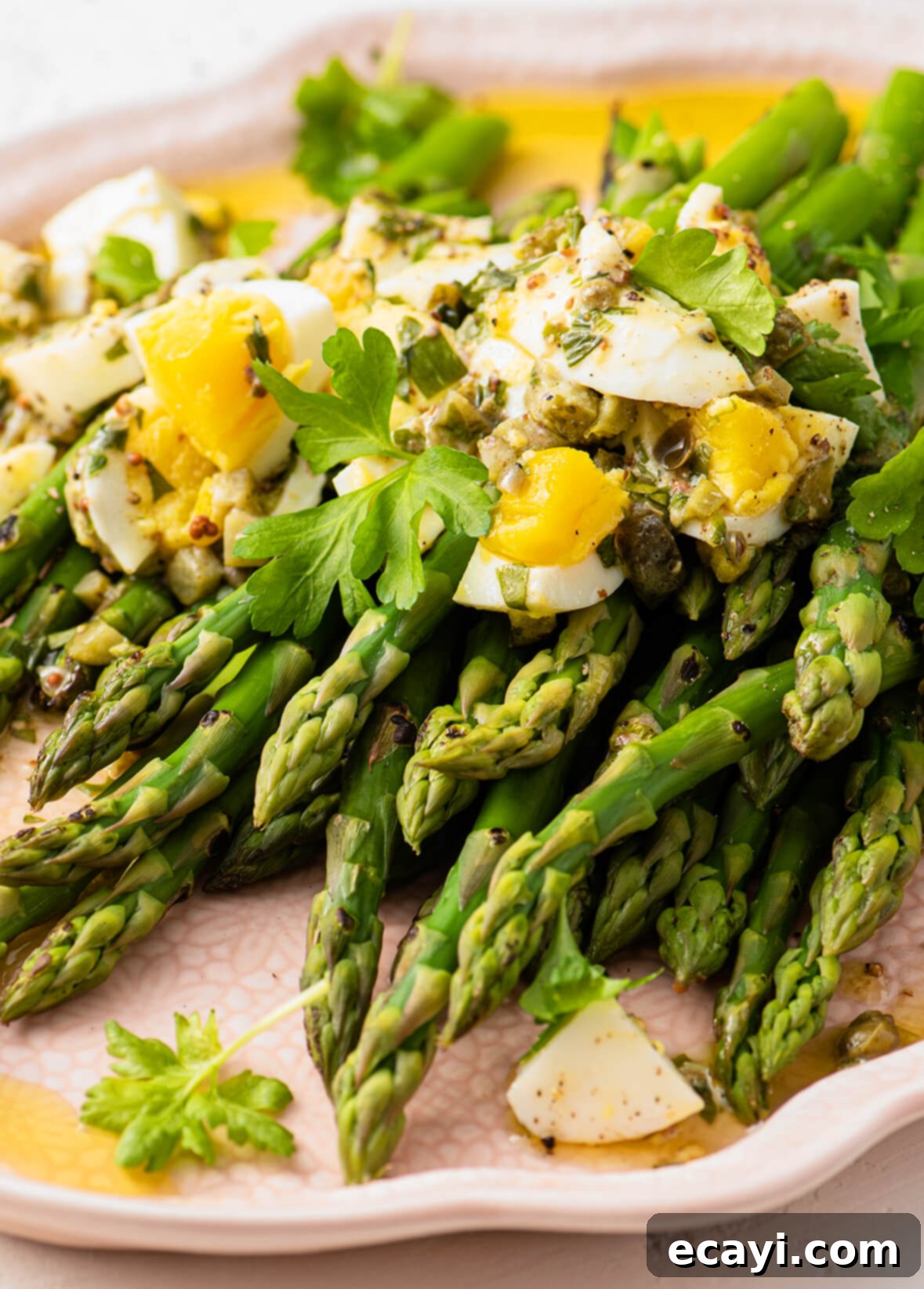
Explore More Fresh Asparagus Recipes for Spring
That beautiful bunch of fresh asparagus nestled in your refrigerator is brimming with culinary potential, isn’t it? If you’re anything like me, sometimes you just need a little inspiration to venture beyond your tried-and-true preparation methods. Perhaps you’ve perfected roasted asparagus, but you’re craving something new and exciting. That’s precisely why I’ve curated this delightful collection of asparagus recipes, designed to spark your creativity and offer a wealth of fresh ideas. From light and irresistible appetizers that are perfect for entertaining, to truly memorable main courses that put this verdant vegetable center stage, and simple yet elegant side dishes that complement any meal, there’s something here for every palate and occasion. Discover 30 irresistible asparagus recipes you should be making right now and celebrate the abundance of spring!
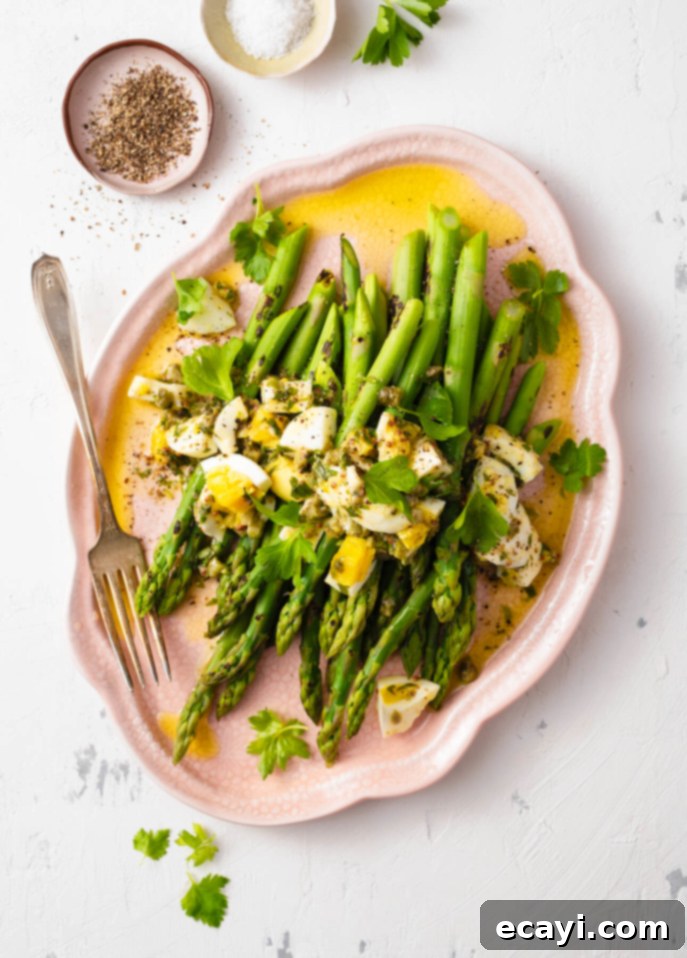
Pin Recipe
Asparagus with Gribiche Dressing
Ingredients
For the asparagus
- Lots of ice cubes
- 1 lb fresh asparagus
For the Gribiche Dressing
- 2 large eggs
- ¼ cup extra-virgin olive oil
- 1 tbsp white wine vinegar, or white balsamic vinegar, or champagne vinegar
- 1 tsp Dijon mustard
- ½ tsp whole-grain mustard (optional)
- 4 to 6 gherkins (also calledcornichons) finely diced (see note)
- 2 tsp drained capers, coarsely chopped
- Pinch fleur de sel, or sea salt flakes
- Freshly ground black pepper, to taste
- 2 to 3 tbsp chopped fresh herbs (tarragon is the traditional choice, but you can also use flat-leaf parsley or dill, or a combination)
Instructions
FOR THE ASPARAGUS
-
Prepare an ice bath: Fill a large mixing bowl with cold water and a generous amount of ice cubes. Reserve a handful of ice for cooling the eggs later.
-
Trim the asparagus: Snap off or slice off the tough, woody ends of the asparagus stalks and discard them. Fill a pot large enough to accommodate the asparagus with water, add a generous pinch of salt, and bring it to a rolling boil.
-
Blanch the asparagus: Add the trimmed asparagus to the boiling water and blanch for 1 minute. Adjust cooking time based on thickness: very thick stalks may need up to 1 minute and 30 seconds, while very thin stalks only require 30 to 45 seconds. The goal is a crisp-tender texture.
-
Cool and drain: Using kitchen tongs, immediately transfer the blanched asparagus to the prepared ice water. This stops the cooking process and helps preserve their vibrant green color. Let them cool completely for 5 to 10 minutes, then drain thoroughly and pat them dry with paper towels. Set aside until ready to serve.
-
Make-ahead tip for asparagus: Once cooled, drained, and patted dry, the asparagus can be refrigerated in an airtight container for up to 2 days.
FOR THE HARD-BOILED EGGS
-
Prepare eggs: Prepare a second small bowl of ice water. Gently place the two large eggs in a small pot and cover them with water. Place over high heat and bring the water to a generous boil. Once the water is boiling, remove the pot from the heat, cover it, and let the eggs rest in the hot water for exactly 10 minutes for perfectly set yolks.
-
Cool eggs: Drain the eggs, then rinse them under cold running water for 1 minute before transferring them to the ice water. Allow them to cool completely for at least 10 minutes.
-
Make-ahead tip for hard-boiled eggs: After cooling, pat the eggs dry and store them (shell on) in the refrigerator for up to 2 days.
FOR THE GRIBICHE DRESSING
-
Chop eggs: Peel the cooled hard-boiled eggs. Chop them according to your preference: finely chopped eggs create a more cohesive dressing, while chunkier pieces offer visual appeal and a delightful textural contrast. Set the chopped eggs aside.
-
Assemble dressing: In a medium bowl, combine the olive oil, vinegar, and both mustards (Dijon and whole-grain, if using). Whisk vigorously until the dressing is well emulsified, ensuring the oil is fully incorporated and not separate. Stir in the finely diced gherkins, coarsely chopped capers, fleur de sel (or sea salt flakes), and freshly ground black pepper. Finally, gently fold in the chopped hard-boiled eggs and fresh herbs. Stir just enough to coat the eggs and herbs with the dressing and seasonings. Taste the gribiche dressing and adjust seasonings, adding more gherkins, capers, or herbs to suit your preference.
SERVING
-
Classic presentation: Arrange the cooked asparagus on a large serving plate. Spoon the freshly made gribiche dressing generously over the asparagus and serve immediately, ideally with some warm, crusty bread on the side to soak up any extra sauce.
-
Individual servings: Alternatively, divide the asparagus among individual plates and spoon a portion of gribiche dressing onto each. Offer additional dressing on the side for guests who may wish to add more.
Notes
Did you make this?
Tell me how you liked it! Leave a comment or take a picture and tag it with @foodnouveau on Instagram.
Disclosure Notice: This site is a participant in the Amazon Associates Program, an affiliate advertising program designed to provide a means for the site to earn fees by linking to Amazon and affiliated sites.
If you click on an affiliate link, I may earn advertising or referral fees if you make a purchase through such links, at no extra cost to you. This helps me creating new content for the blog–so thank you! Learn more about advertising on this site by reading my Disclosure Policy.
